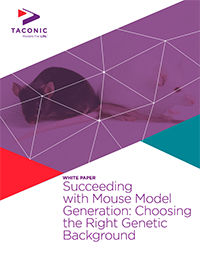Homologous recombination (HR) is a fundamental genetic process that allows an exchange or unidirectional movement of genetic material between regions of high DNA sequence identity. Due to its preciseness, HR was first used to generate targeted knockouts in mouse embryonic stem (ES) cells in the late 1980s, followed by other types of genetic modifications. To this day, large genomic replacements and other complex genetic modification projects often require the use of traditional HR in ES cells, while generating smaller genetic changes may be feasible by using in vivo CRISPR/Cas9-mediated methods.
An ES cell-based HR project begins with designing a targeting vector that contains the DNA sequence or gene of interest (GOI) flanked by homology arms, regions that are homologous to the target locus in the ES cell genome. Included within the gene targeting vector are “positive” selection markers such as neomycin or puromycin resistance genes, as well as a “negative” selection marker (placed outside the homology arms) to allow for selecting against ES cell clones with random integration of the targeting vector. An important requirement for a successful project is the availability of an ES cell line that has high germline competence, or one that can contribute to the formation of germ cells when injected into host blastocysts.

The next step in the process involves introducing the targeting vector into the ES cells by electroporation. The ES cell clones that have undergone successful HR are selected for by the appropriate positive and negative selections and screened for the presence of a successful targeting event. These candidate ES cell clones are then fully validated by Southern blotting with multiple probes to confirm correct targeting at both the 5’ and 3’ ends of the vector, as well as the absence of randomly integrated vectors. The validated ES cell clones subsequently undergo ploidy screening, and the removal of selection cassettes. The next step of the process involves the injection of validated ES clones into blastocysts from another strain of mice that is differentiable from the strain of ES cells by its coat color. The injected host blastocysts are then implanted into pseudopregnant surrogate female mice. When a litter is born, the presence of chimeric mice with patches of two different coat colors indicates the contribution of injected ES cells to the host embryo. Chimeric male mice with a high coat color contribution from the injected ES cells are then traditionally selected for germline transmission.

These chimeric male founders are sacrificed, and sperm are cryopreserved. Quality control is performed on the sperm to identify the chimeric founder mice with the highest percentage of the targeted allele in the germline, and one that can be reliably expanded via in vitro fertilization (IVF). Cryopreserved sperm from the selected chimeric founders can be used to expand the line by IVF using oocytes from the same strain as the ES cells. The presence of F1 pups with the same coat color as that of the ES cells indicates germline transmission of the targeted ES cells. Half of these ES cell-derived pups are then expected to be heterozygous for the targeted allele. The F1 pups carrying the targeted allele can be further bred or expanded via IVF to obtain a cohort of experimental mice.
Taconic's ExpressMODEL® Embryonic Stem Cell platform provides the opportunity to not only de-risk multiple steps of this process (ensuing a higher reliability of timeline to the production of F1 mice), but also the ability to produce a high number of F1 heterozygotes, if this may be beneficial for downstream work.

Featured Resources
















.jpg)

.jpg)
.jpg)
.jpg)
.jpg)





.jpg)


.jpg)
.jpg)




.jpg)




.jpg)

.jpg)






